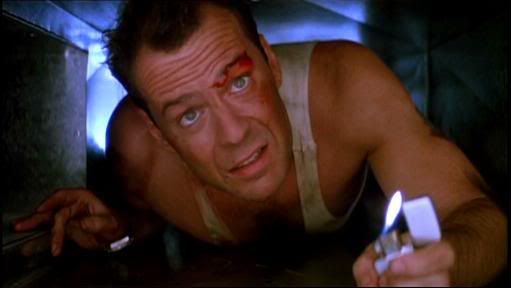
While inexplicably enduring the uninspired and tedious action movies that I often subject myself to, thanks to their connection to a franchise I once enjoyed (thank you, G.I. Joe: Rise of Cobra) or a video-game I loved (looking at you, Max Payne), I usually find my mind wandering back to the film that remains my holy grail of the genre: Die Hard. As far as action movies go, it has remained my absolute favourite film for nearly 20 years. I watch it twice a year at the very least and seem to be incapable of enjoying it less with each subsequent viewing.
There are many reasons why Die Hard is a great film - using 'great' in a completely unironic fashion - but the one I've been thinking about today is the film's use of environments. This was brought on by my discovery (via Warren Ellis) of writer/essayist Geoff Manaugh's awesomely aca-fan-ish post on the film on BLDGBLOG, his blog about architecture and urban spaces. In the post, entitled 'Nakatomi Space', Manaugh talks about how Die Hard is 'one of the best architectural films of the last 25 years', an opinion that I have shared on some gut level, way back from when I first saw it as a eight year old who didn't know what the word 'architecture' meant. I never really had the conceptual language to communicate that instinct but Manaugh does - articulating wonderfully just what makes the movie so spatially fascinating and how that makes it that much more exciting. Go read.
This deft interaction between characters (antagonists as well as protagonist - "Shoot. The Glass") and their environments is at the heart of what makes Die Hard as compelling as it is, a lesson that needs to be learned by all the purveyors of epic-scale violence and empty explosions that pervade the genre. After a while, even the biggest explosions and gunfights get tedious and the films that successfully sustain a 90 minute adrenaline rush are the ones that exploit action on a smaller scale - simply by remembering that connection between the protagonist and his surroundings. Die Hard's director John McTiernan has always been good at this; see also his sci-fi actioner Predator - another enduring favourite of mine - for an example of further ingenious use of environment. It is no surprise then that the descendants of films like Die Hard are (in my opinion, anyhow) the best of contemporary actioners. Cases in question - the Bourne trilogy and the Bond reboots (very decidedly not their predecessors), particularly Casino Royale.
These films also rely on characters drawing from their surroundings to defeat the enemy, even subverting what might be construed as obstacles (extreme heights, security fences, walls) and using them to great benefit. Jason Bourne, in particular, uses built spaces as an extension of his body. As Matt Jones effectively puts it - "Bourne wraps cities, autobahns, ferries and train terminuses around him as the ultimate body-armour". Even combat sequences are up-close and personal (as in Die Hard) with hand to hand combat and gunfights in enclosed spaces ratcheting up adrenaline levels in this viewer far more than any of the city-wide explosions or other distancing spectacles that are so common in the boring movies I mentioned earlier. Large scales are employed judiciously and to much greater effect for that judiciousness.
The best action directors occasionally employ the two levels in conjunction - the bank shoot-out in Heat being the obvious example of this (along with being possibly the greatest cinematic shootout ever!). Heat's director Michael Mann (an admirer of McTiernan's) is brilliant at incorporating architecture into his filmmaking. In the film's central shoot-out, he reduces what is - on paper - a large scale gun battle to a series of tight tracking shots and close-ups inter-cut with establishing long shots in a superbly kinetic alternation between the intimate and the panoramic. A scene with a bunch of robbers shooting at a bunch of cops could have degenerated rather quickly into the rote series of bodies dropping and things blowing up that one sees in the average Michael Bay movie but by reining in a large scale engagement to an intimate perspective, Mann makes you forget to breathe until the last shot is fired. And at no point do the filmmakers forget that the downtown L.A architecture is as significant an influence on the proceedings as the people pulling the triggers.
It really is too bad that so many action directors these days forget that incorporating larger explosions, more bullets and armies of ready-to-die redshirt types does not always lead to a more exciting experience. McTiernan's one-cop-and-his-Beretta-trapped-in-a-building has them all beat.


No comments:
Post a Comment